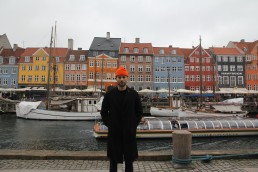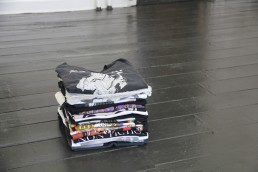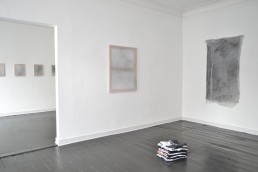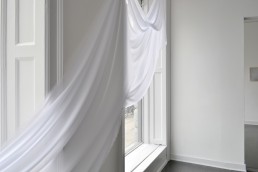Interview with Artist Alessandro Moroder
by Fernanda Lai
Alessandro Moroder’s first solo exhibition in Copenhagen Honey is currently on show at the Marie Kirkegaard gallery. In Honey, Moroder continues his performative mark-making processes while experimenting with new materials and investigating disparate themes such as time, memory and materiality. We visit Alessandro Moroder the day before the exhibition begins, to talk about location and memory in his work and processes.

Artland: Can you tell us more about the title of the exhibition — Honey?
Moroder: I don’t have a specific reference in mind with the title. I had originally considered another title based on a James Baldwin quote — And There They Seemed, Bathed In Silence. All Alone — but it seemed a little too dramatic, and I ended up using the quote for the title of a painting instead. Honey doesn’t come from a specific thing. I constantly write one-word notes in my notebook, not even phrases, just things that stick with something I’m working on. A lot of the works I make start with nature— I just thought of this — the silk chiffon in this exhibition comes from silkworms which goes back to honey and honeybees.
I try not to put too much into the title of the show, because I usually have a lot of references that go into the singular title of the pieces. I always want the title of show to be a little looser and not as overpowering. Some of my other shows have had a slight reference, but they are always personal, and intentionally, it’s not something that’s obvious in the work, which is. I do have an affinity for short titles, like 8 for my show in New York at ASHES/ASHES, and HELL at Rolando Anselmi.
Artland: How do you come up with titles from your pieces then? Do they also come from your notebook?
Moroder: No, because a body of work from me is always going to look very similar. I have to take very diligent notes, otherwise it is impossible for me to tell which one is which. A lot of them are titled in chronological order by number. Sometimes it’s a bit more straightforward, such as for this piece with the t-shirts, I just took the words from the top t-shirt Say Your Prayer as the title. I wanted that to be obvious. I rarely do something like the James Baldwin quote, where there is a secondary reference.

Artland: Does the title often come at the end of the work then?
Moroder: Yes. I find the title to be very important, because it gives the viewer an additional nudge in the right direction. At the same time, I don’t want it to be overbearing and make the decision for you. I was reading a James Baldwin book while making this work and I decided to not name the show after the Baldwin quote I mentioned earlier, so that the book becomes a third reference between this African-American writer, me and having this show in Copenhagen. I don’t want to present a work that is so referential, pinpointed and direct that people can’t make their own assessment. You don’t want your audience to feel constrained. It can end up being distracting.
Artland: Many of these works play with the possibilities for stretching cloth, whether that’s silk chiffon, cheesecloth or regular cotton. Could you talk about how you arrived at that process?
Moroder: In all my works and every series or show, I try to push myself with materiality and presenting the work in a specific way. I will always look back at shows and see what was successful and try to push it a bit more. It all comes back to how I was very much a painter when I studied at Cal Arts, almost in reaction to a perceived decline in painting at that time. I still consider myself a painter first and foremost, and perhaps a painter in this instance by stretching fabric over canvas, since there isn’t any paint in here and I haven’t used any paint in my works in around a decade.
Artland: I can see that. Could you elaborate on how you began to make these works?
Moroder: In some pieces, I started by draping cloth over canvas and spray painting it, and it progressed to doing them as dirt paintings which then added a reference to specific locations that were personally important to me, since they use the natural elements of those areas to create the work. Ten Sheets Of Used Cloth is the first work I made for this exhibition and it’s the first work I’ve ever done that was originally a painting. I wanted to push it to see how it would work as an installation, and I challenged myself to not only utilise the stretcher bars as stretcher bars. I wanted the stretcher bars to be apparent and present as they operate within the work, be visible, and not just be a stretcher bar for a stretcher bar’s sake.

I wanted the stretcher bars to be apparent and present as they operate within the work, be visible, and not just be a stretcher bar for a stretcher bar’s sake.
Artland: There’s a lot of layers of presence and absence in this particular exhibition, which you really feel with the use of cloth. Is there a meaning to these materials? Silk chiffon is just such a luxurious fabric, for example, and cheesecloth is something more simple and practical, almost rustic.
Moroder: I’ve always been interested in fabric, especially how they look in Renaissance sculptures and paintings. Within the last two years I’ve been obsessed with Antonio Canova and his amazing sculpture of Perseus with the Head of Medusa, which has this piece of fabric draping quietly and weightlessly across Perseus’s forearm. His ability to make marble look like cloth is otherworldly.
Artland: Actually, silk chiffon, cheesecloth and cotton are not the only fabrics present in the show, you also have one piece made up entirely of your own t-shirts.
Moroder: For me, these t-shirts really show the idea of an index. The t-shirts are all mine, a couple of them are fifteen years old, so there’s a reference to all of them, although it’s not obvious to the viewer. It’s the first time where a viewer can see a signifier in my work, because there’s a band T-shirt with this sort of logo or date. It’s an additional reference point, in contrast to the more vague reference of my other pieces. I’ve had these shirts my whole life so I know exactly where they are from. I also have this one t-shirt where it’s a piece of cloth that mimics a t-shirt, and it’s a specific reference inside a specific reference.
Artland: It’s like your exhibition t-shirt.
Moroder: Haha, exactly. It’s my merchandise I’ll be selling.

Artland: Was it easy to figure out where you wanted to put Say Your Prayer ? It’s so clear to me that it’s the most personal piece and more referential than the other works in the exhibition.
Moroder: Marie put it there in this second room. I think it works better here. You have a moment after you come in before you interact with something that’s incredibly personal. I didn’t want it to be the first thing you see since it’s my first solo show in Copenhagen, and it’s probably the visitor’s first time seeing my work. These t-shirts are clearly something that have been cherished, kept and maintained. I wanted to ease the viewer into this part, because like you said, it is the most personal.
I’ve had this Metallica shirt since 8th grade and it doesn’t fit anymore, but not for all the money in the world would I give it away. It’s just a Metallica shirt. I remember the salespeople saying, “You can get this one or the more expensive one that looks vintage but isn’t vintage, just cracked.”
Artland: And which one did you get?
Moroder: Haha, I got the more expensive one of course. It’s not a collector’s piece, but I’ve had it for more than half of my life. I could never wear it again, but I’ll never get rid of it. I’ve had it since 8th grade.

Artland: The word “index” has come up a lot in our discussion. Does this exhibition reflect a new way of thinking about memory and event for you?
Moroder: Before this show I had this idea around material and memory and how different materials allude to different memories. Silk chiffon could be more sexual, with its buoyancy and translucent beige quality. It looks a bit like flakes of skin. I don’t know if I think of memory differently now, but I know I was consciously trying to think of how we interpret memory through material, the same way taste and smell is so important. It’s obvious to me that when you think through your childhood, you recall specific smells and tastes, and there’s a lot of nostalgia. It’s comforting and welcoming. I can’t think of many instances where I remember material as being a placeholder for memory for me.
Artland: In your work, to me it seems like location is one of the biggest placeholders for memory and it’s also such a big part of your process. Could you tell us a little more about how location figures into this particular show?
Moroder: Within my work, I’ve only ever worked at the Salton Sea, this crazy, putrid, desolate, man-made lake outside of Los Angeles. It looks like the moon, this post-apocalyptic wasteland. The other place is the Dolomite Mountains, where my dad is from. I’ve also done work in San Pedro in Mexico, though not for this particular exhibition. These locations are pretty special to me. I spent a year or two in Italy when I was young. I go back once every year or two, and my parents live there now. These places all have indexes and I don’t see myself using any more places other than those locations. My fear is that if I do it in too many locations, it becomes less special. It becomes more like collecting a postcard, which lessens the value of those three locations.

I always try to find these little areas or moments to create an alternative and secondary conversation with the work.
Artland: Does it change things to see your work in Copenhagen, just because location is so important to your work and process?
Moroder: I don’t think so. It’s more about the gallery than where the gallery is located. When I got the opportunity to show here, I remember the first thing I noticed were these two windowpanes. That was the very first thing I thought of — it has to be presented in a way that makes sense on the inside and the outside. I haven’t really gotten the opportunity to show a work at street level before.
This is one of my favourite moments in the show, using this corner here that you can’t see from the outside and I didn’t know that we had. I love the way it changes how the fabric is draped. This goes back to my time at Cal Arts where you had to think about everything — why is it stretched? Why is it draped? Why is it on the floor? Everything is meant to be thought of. That’s why I was so concerned with utilising this space from both the inside and outside. Not all galleries have the same layout and you have to take into consideration space and the nuances of it. Maybe the work (One Sheet Of Used Silk, 2019) is just presented as a piece on the wall and that’s it, but I always try to find these little areas or moments to create an alternative and secondary conversation with the work.
Honey, by Alessandro Moroder, is showing at Marie Kirkegaard Gallery from 22. March to 4. May 2019.
Address: Holbergsgade 17 C, København K
Opening Hours: Tuesday – Friday 12-18, Saturday 12-15